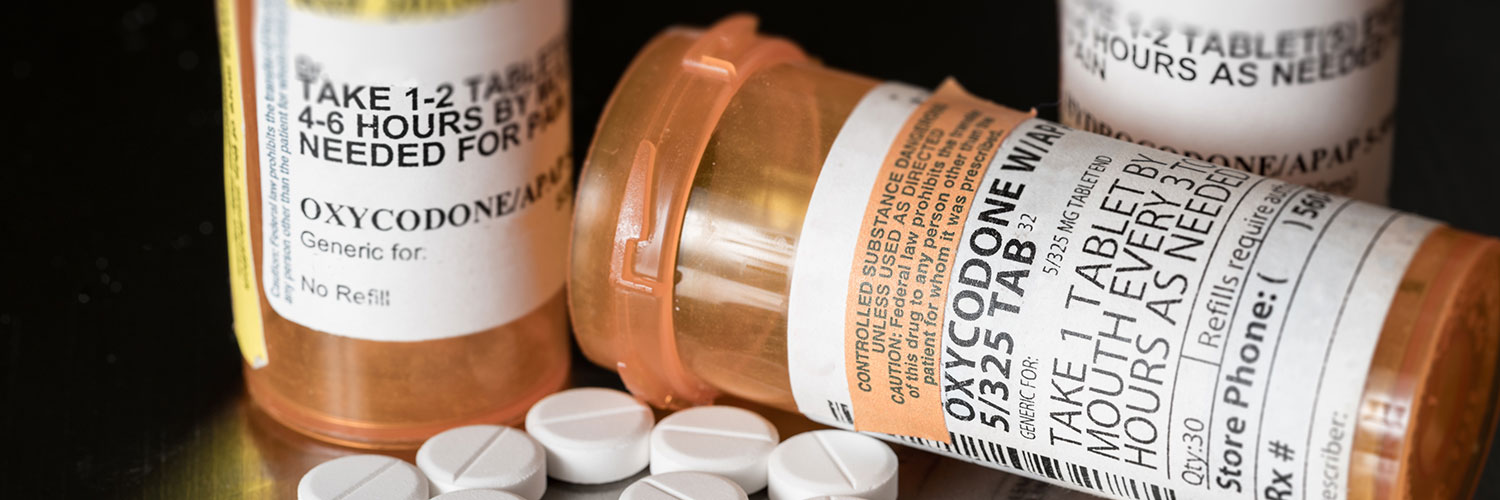CDC Releases New Guidelines Over Opioid Prescriptions

The Centers for Disease Control and Prevention has released new guidelines for clinicians on when and how to prescribe opioids for pain.
The new guidance replaces the agency's 2016 recommendations, which were criticized by some doctors and patients for encouraging an anti-opioid culture. According to the updated guidance, doctors, insurers, pharmacies, and regulators occasionally misapplied the older guidelines, resulting in significant harm to some patients, including untreated and undertreated pain, severe withdrawal symptoms, worsening pain outcomes, psychological distress, overdose, and suicide.
The 100-page document and its topline recommendation serve as a road map for prescribers navigating the difficult issue of treating pain, including advice on dealing with pain relief after surgery and managing chronic pain conditions, which are estimated to affect one in every five Americans.
The 2016 guidelines had a significant impact on policy, fueling a push by insurers, state medical boards, politicians, and federal law enforcement to reduce opioid prescribing.
Doctors and researchers say the fallout is difficult to overstate because it is a crisis of untreated pain. Many patients with severe chronic pain had their long-term prescriptions quickly reduced or discontinued, sometimes with disastrous consequences such as suicide or overdose, as they turned to a tainted supply of illicit drugs.
Federal agencies attempted to correct the course by emphasising that the older voluntary guidelines were not intended to become strict policies or laws. However, doctors and patient advocates hoped that the CDC's updated guidelines would reverse some of the unintended consequences of the previous guidance.
When the CDC announced the new clinical guidelines, it was clear that this was on their minds. The updated guidelines' co-author, the acting director of the CDC's National Center for Injury Prevention and Control, stated that the recommendations are voluntary and intended to guide shared decision-making between a clinician and a patient. It is not intended to be implemented as absolute policy or practise limits by clinicians, health systems, insurance companies, or government entities.
The new guidelines continue to emphasize that opioids should not be the first line of treatment in many cases, citing evidence that other treatments and approaches are frequently comparable for improving pain and function. The recommendations, however, make it clear that the guidance should not be used to replace clinical judgement and that clinicians can work with patients who are in pain, even if that means keeping them on opioids.
The new guidance's most significant changes come in the form of 12 bullet points that outline general prescribing principles.
Unlike the 2016 version, those takeaways no longer include specific limits on the dose and duration of an opioid prescription that a patient can take, though the document does warn against prescribing above a certain threshold further down. The new guidelines also expressly caution doctors against abruptly tapering or discontinuing opioid prescriptions for patients who are already on them, unless there are signs of a life-threatening problem.
Prescription restrictions became a policy or law as a result of previous guidelines. Even though the new guidelines state that they are not intended to be implemented as absolute limits for policy or practice, it is unclear whether those rules will be rewritten in light of the new guidelines.
NY To Get $524M From Teva Over Opioid Crisis

Teva Pharmaceutical Industries Ltd will pay up to $523 million to New York State as part of a nationwide settlement of lawsuits alleging that the company aided in the spread of the opioid epidemic in the United States.
Teva's total opioid payouts will increase by $300 million as a result of the settlement with New York. Teva is working to finalize a nationwide settlement worth more than $4.2 billion, with New York already set to receive cash and medication as part of the agreement.
It is impossible to put a price on lives lost, addiction suffered, and families torn apart, according to the New York attorney general, but with more than $2 billion, it is easier to rebuild and recover New York.
The Teva settlement brings the state's litigation against opioid manufacturers and distributors to a close. CVS Health Corp, Walgreens Boots Alliance, and Walmart also agreed to pay $13.8 billion to settle thousands of state and local lawsuits involving opioid pain medications dispensed by their pharmacies in the United States.
Teva's CEO stated that the payment to New York will be made over 18 years, which is good for the company because it means that it will be very manageable in terms of cash flow and debt. Teva's net debt has decreased but remains significant at $19 billion.
The CEO even stated that the company is extremely pleased with the outcome. Teva reported third-quarter results that fell short of expectations, sending its Tel Aviv-listed shares down more than 6%. Teva's stock on the New York Stock Exchange was down 1.5% at $8.63.
Teva proposed a $4.25 billion nationwide settlement, mostly in cash and partly in medicines, to resolve opioid lawsuits in July, amounting to $300 million to $400 million over 13 years. Only the New York agreement pays out over an 18-year period. Teva anticipates that payments will begin in 2023, but the opt-in process for states and local governments has begun and will take several months to complete.
The CEO also stated that the company is optimistic about resolving the many states and subdivisions that will join the litigations. The world's largest generic drugmaker lowered its full-year revenue forecast and reported lower-than-expected third-quarter profit, blaming a stronger US dollar.
Teva reported adjusted earnings of 59 cents per share for the quarter, which were unchanged from the previous year but 3 cents a share lower than analyst expectations. Revenue fell 8% to $3.6 billion, falling short of Wall Street's forecast of $3.83 billion. Teva reduced its revenue forecast for 2022 from $15 billion to $15.6 billion to between $14.8 billion and $15.4 billion, citing "continued foreign exchange headwinds." The revenue for last year was $15.9 billion. The adjusted earnings per share forecast for 2022 remains unchanged at $2.40 to $2.60.
CVS & Walgreens To Pay $10B Opioid Settlement

CVS Health and Walgreens announced on Wednesday that they had reached an agreement in principle to pay a total of $10 billion to settle a series of opioid-related lawsuits filed against the pharmacy chains.
CVS announced a $5 billion settlement to "substantially resolve" the open opioid lawsuits against it. CVS's chief policy officer and general counsel stated that the company is pleased to resolve these long-standing claims and put them behind them in the best interests of all parties, including our customers, colleagues, and shareholders. He went on to say that the company is committed to working with states, municipalities, and tribes, and that it will continue to support important initiatives aimed at reducing the illegal use of prescription opioids.
Walgreen also stated that it had reached an agreement in principle on a $4.95 billion settlement to be paid over 15 years. According to a spokesperson for Walgreens, the company remains committed to being a part of the solution, and this settlement framework will allow the organization to keep the focus on the health and well-being of customers and patients while making positive contributions to addressing the opioid crisis.
The spokesperson for Walgreens even stated that the company believes that this is in the best interests of the company and the stakeholders at this time and that it allows pharmacists, dedicated healthcare professionals who live and work in communities, to serve and continue to play a critical role in providing education and resources to help combat opioid misuse and abuse.
CVS stated that the national settlement, which has been reached in principle, would resolve lawsuits filed by states and other governments. Some of these allegations go back a decade or more. According to the company, the settlement is not an "admittance of any liability or wrongdoing."
CVS Health stock rose about 4% after the company released third-quarter earnings alongside the settlement announcement. Walgreens' stock increased by about 2%.
Depending on the number of governmental entities that agree to join the settlement, CVS's settlement payments would be spread out over a 10-year period beginning in 2023. According to CVS, the parties are still negotiating the "non-monetary" terms of the settlement.
CVS's payments would include approximately $4.9 billion to states, cities, counties, and other political plaintiffs, according to CVS. According to the statement, tribes would receive approximately $130 million.
McKinsey Sued Over Opioid Crisis By LI & Fire Districts

Long Island townships, villages, and fire districts are suing consulting firm McKinsey, accusing the firm of boosting opioid sales, which they claim resulted in the deaths of thousands of New Yorkers.
The company was charged with violating state business laws that govern deceptive acts and practises, false advertising, negligence, misrepresentation, and fraud. McKinsey did not respond to the lawsuit right away.
According to the lawsuit, the municipalities suffered economic damage as a result of McKinsey, including treatment costs for those suffering from opioid-related addiction, infants born with opioid-related medical conditions, and law enforcement and public safety response to the opioid epidemic.
The lawsuit even alleges that prescription opioid sales have increased since the mid-1990s as manufacturers pushed "aggressive sales strategies." According to the plaintiffs, there has been a "dramatic increase" in opioid prescriptions in New York, which has resulted in an increase in opioid abuse, dependence, addiction, and overdose deaths.
The lawsuit even claims that prescription opioids kill hundreds of New Yorkers each year, while thousands more suffer from negative health consequences. The plaintiffs claim that the addiction or death of a friend or family member has ruined the lives of countless others. Every community in New York is affected by the opioid addiction and death crisis.
According to the lawsuit, McKinsey began "turbocharging Purdue's Sales Engine" and increasing OxyContin revenue for Purdue in 2013. OxyContin is an oxycodone narcotic used to treat moderate to severe pain, but it is highly addictive and addictive. When combined with other substances, particularly alcohol or other illicit drugs like heroin or cocaine, it can cause respiratory distress and death.
The lawsuit further notifies that McKinsey advised Purdue as part of the "Project Turbocharge" recommendations that having people visit high-prescribing doctors multiple times per year increased sales. According to the plaintiffs, McKinsey determined that the top half of prescribing physicians "write on average 25 times more scripts per prescriber" than the lower half.
The lawsuit mentions that OxyContin sales peaked in 2013, the year McKinsey and Purdue implemented "Project Turbocharge." According to the plaintiffs, overall opioid prescriptions peaked three years ago. Purdue eventually discontinued the drug's marketing in 2018.
Latest Zantac Study Indicates Increased Risk Of Cancer

Plaintiffs have submitted supplemental expert reports for evaluation to the U.S. District Judge presiding over the Zantac MDL following the publication of a new study that provides evidence about the Zantac cancer risks.
The Court considered the reports to determine whether there is sufficient reliable scientific support for thousands of lawsuits alleging that the recalled heartburn medication caused cancer.
Zantac (ranitidine) was taken off the market in late 2019 after it was discovered that the active pharmaceutical ingredient is inherently unstable and produces high levels of the chemical byproduct N-Nitrosodimethylamine (NDMA), which is a potent human carcinogen.
More than 100,000 Zantac cancer lawsuits have been filed against GlaxoSmithKline, Boehringer Ingelheim, Pfizer, Sanofi, and other manufacturers, distributors, and retailers involved in the sale of a brand name or generic ranitidine pills by former users who claim they were diagnosed with bladder cancer, esophageal cancer, liver cancer, pancreatic cancer, stomach cancer, or other injuries as NDMA moved through their bodies.
Given the common factual and legal issues raised in Zantac lawsuits filed across the federal court system, centralised pretrial proceedings have been established in a federal MDL before a U.S. District Judge in the Southern District of Florida, who has been presiding over coordinated discovery and a "bellwether" process in which a small group of cases are being prepared for early trial dates.
Before allowing the first Zantac trials to begin, the judge held a series of Zantac "Daubert" hearings over the past several weeks to evaluate the qualifications of various experts who will testify at trial and confirm that the opinions are sufficiently sound and reliable to allow juries to consider the evidence under federal court evidence standards. However, a study released in the midst of these hearings has provided additional support for plaintiffs.
Taiwanese researchers published a study in late September that adds to the evidence that there is a link between Zantac use and several types of cancer, including liver, lung, gastric, and pancreatic cancer.
Researchers conducted a population-based cohort study on over 55,000 people who used Zantac between January 2000 and December 2018. They compared cancer rates among Zantac users to those who used other heartburn medications, such as proton pump inhibitors (PPIs) such as Nexium and Prilosec, and Pepcid AC (famotidine).
Zantac use was linked to a 22% increased risk of liver cancer, a 17% increased risk of lung cancer, a 26% increased risk of gastric cancer, and a 35% increased risk of pancreatic cancer, according to the findings.
